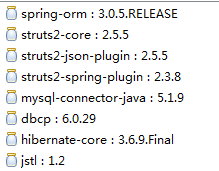搭建簡單的SSH框架例項
1.匯入所依賴的架包

2.配置web.xml檔案
<!--配置spring 容器用於初始化容器 --> <listener> <listener-class>org.springframework.web.context.ContextLoaderListener</listener-class> </listener> <context-param> <param-name>contextConfigLocation</param-name> <param-value>classpath:spring-*.xml</param-value> </context-param> <!--配置struts --> <filter> <filter-name>struts</filter-name> <filter-class>org.apache.struts2.dispatcher.filter.StrutsPrepareAndExecuteFilter</filter-class> </filter> <filter-mapping> <filter-name>struts</filter-name> <url-pattern>/*</url-pattern> </filter-mapping>
3.配置spring-hibernate.xml
<!--開啟元件掃描 --> <context:component-scan base-package=""/> <!--定義資料來源 --> <!--配置資料庫連線 --> <bean id="dataSource" class="org.apache.tomcat.dbcp.dbcp.BasicDataSource"> <property name="url" value="jdbc:mysql:///資料庫名?useUnicode=true&characterEncoding=UTF-8"/> <property name="driverClassName" value="com.mysql.jdbc.Driver"/> <property name="username" value="賬戶"/> <property name="password" value="密碼"/> </bean> <!--配置sqlSessionFactory --> <bean id="sqlSessionFactory" class="org.springframework.orm.hibernate3.LocalSessionFactoryBean"> <!--連線資料庫 --> <property name="dataSource" ref="dataSource"/> <!--配置hibernateTemplace --> <property name="hibernateProperties"> <props> <--使用hibernate方言--> <prop key="hibernate.dialect">org.hibernate.dialect.MySQLDialect</prop> 控制檯顯示相關的HQL <prop key="hibernate.show_sql">true</prop> 格式化HQL <prop key="hibernate.format_sql">true</prop> </props> </property> <!--配置對映檔案 --> <property name="mappingLocations"> <list> <value>classpath:mappings/XX.hbm.xml</value> </list> </property> </bean> <!--配置事務管理 --> <bean id="txManager" class="org.springframework.orm.hibernate3.HibernateTransactionManager"> <property name="sessionFactory" ref="sqlSessionFactory"/> </bean> <!--開啟事務註解驅動 --> <tx:annotation-driven transaction-manager="txManager"/> <!--配置hibernateTemplace --> <bean id="hibernateTemplate" class="org.springframework.orm.hibernate3.HibernateTemplate"> <property name="sessionFactory" ref="sqlSessionFactory"/> </bean>
4.配置struts.xml
<struts> <package name="Link" namespace="/" extends="struts-default"> <action name="hreo_*" class="hreoAction" method="{1}"> <result name="success" >/jsp/list.jsp</result> <result name="update">/jsp/update.jsp</result> <result name="add">/jsp/add.jsp</result> <result name="redirect" type="redirectAction">hreo_list</result> </action> </package> </struts>
5.index.jsp
<%@ page language="java" contentType="text/html; charset=UTF-8"
pageEncoding="UTF-8"%>
<%@taglib uri="http://java.sun.com/jsp/jstl/core" prefix="c"%>
<!DOCTYPE html PUBLIC "-//W3C//DTD HTML 4.01 Transitional//EN" "http://www.w3.org/TR/html4/loose.dtd">
<html>
<head>
<meta http-equiv="Content-Type" content="text/html; charset=UTF-8">
<title>主介面</title>
</head>
<body style="font-size: 30px;">
<form action="${pageContext.request.contextPath }/hreo_list.action" method="post">
<input type="submit" value="進入">
</form>
</body>
</html>6.list.jsp
可以使用OGNL或者EL表示式,根據個人愛好
不知道啥是OGNL表示式的看我部落格文章---小東昇職記---裡面有例項說明
<%@ page language="java" contentType="text/html; charset=UTF-8"
pageEncoding="UTF-8"%>
<%@ taglib uri="http://java.sun.com/jsp/jstl/core" prefix="c"%>
<!DOCTYPE html PUBLIC "-//W3C//DTD HTML 4.01 Transitional//EN" "http://www.w3.org/TR/html4/loose.dtd">
<html>
<head>
<meta http-equiv="Content-Type" content="text/html; charset=UTF-8">
<title>展示頁面</title>
<style type="text/css">
table {
border: 1px solid #ccc;
margin: 100px auto;
border-collapse: collapse;
}
table td {
border: 1px solid #ccc;
}
tfoot {
text-align: center;
font-family: 楷體;
font-size: 15px;
}
</style>
</head>
<body>
<div>
<table>
<thead>
<tr>
<td>英雄名稱</td>
<td>英雄屬性</td>
<td>英雄位置</td>
<td>英雄名綽號</td>
<td>英雄操作</td>
</tr>
</thead>
<c:forEach items="${list }" var="list" step="1">
<tbody>
<tr>
<td>${list.h_name }</td>
<td>${list.h_properties }</td>
<td>${list.h_loc }</td>
<td>${list.h_nick }</td>
<td>
<a href="${pageContext.request.contextPath }/hreo_detail.action?h_name=${list.h_name}">修改</a>
<a href="${pageContext.request.contextPath }/hreo_delete.action?h_name=${list.h_name}">刪除</a>
</td>
</tr>
</tbody>
</c:forEach>
<tfoot>
<tr>
<td colspan="5">拳頭出品</td>
</tr>
</tfoot>
</table>
</div>
</body>
</html>7.編寫一個簡單的控制層
/**
*
*/
package com.zhiyou100.action;
import java.util.List;
import javax.annotation.Resource;
import org.springframework.context.annotation.Scope;
import org.springframework.stereotype.Controller;
import com.opensymphony.xwork2.ActionContext;
import com.opensymphony.xwork2.util.ValueStack;
import com.zhiyou100.entity.Hero;
import com.zhiyou100.service.HreoService;
/**
* @author Administrator
*
*/
@Controller
@Scope("prototype")
public class HreoAction {
@Resource
private HreoService hreoService;
public HreoService getHreoService() {
return hreoService;
}
public void setHreoService(HreoService hreoService) {
this.hreoService = hreoService;
}
@Resource
private Hero hero;
public Hero getHero() {
return hero;
}
public void setHero(Hero hero) {
this.hero = hero;
}
private String h_name;
public String getH_name() {
return h_name;
}
public void setH_name(String h_name) {
this.h_name = h_name;
}
public String list() {
List<Hero> list = hreoService.findAll();
ValueStack stack = ActionContext.getContext().getValueStack();
stack.set("list", list);
return "success";
}
public String delete() {
Hero hero2 = hreoService.FindByName(h_name);
hreoService.delete(hero2);
return "redirect";
}
public String detail() {
Hero hero2 = hreoService.FindByName(h_name);
ValueStack valueStack = ActionContext.getContext().getValueStack();
valueStack.set("hero", hero2);
return "update";
}
public String update() {
hreoService.update(hero);
return "redirect";
}
}
8.服務層我就只寫實現類,介面不在寫
/**
*
*/
package com.zhiyou100.service.impl;
import java.util.List;
import javax.annotation.Resource;
import org.springframework.stereotype.Service;
import com.zhiyou100.dao.HreoDao;
import com.zhiyou100.entity.Hero;
import com.zhiyou100.service.HreoService;
/**
* @author Administrator
*
*/
@Service
public class HreoServiceImpl implements HreoService{
@Resource
private HreoDao hreoDao;
public List<Hero> findAll() {
// TODO Auto-generated method stub
return hreoDao.FindAll();
}
public void delete(Hero hero) {
// TODO Auto-generated method stub
hreoDao.delete(hero);
}
public Hero FindByName(String name) {
return hreoDao.FindByName(name);
}
public void update(Hero hero) {
// TODO Auto-generated method stub
hreoDao.update(hero);
}
}
9.持久層只寫實現類
/**
*
*/
package com.zhiyou100.dao.impl;
import java.util.List;
import javax.annotation.Resource;
import org.springframework.orm.hibernate3.HibernateTemplate;
import org.springframework.stereotype.Repository;
import org.springframework.transaction.annotation.Transactional;
import com.zhiyou100.dao.HreoDao;
import com.zhiyou100.entity.Hero;
/**
* @author Administrator
*
*/
@Repository
@Transactional
public class HreoDaoImpl implements HreoDao{
@Resource
private HibernateTemplate hibernateTemplate;
public List<Hero> FindAll() {
// TODO Auto-generated method stub
@SuppressWarnings("unchecked")
List<Hero> list = hibernateTemplate.find("from Hero where h_status = 1");
if (list!=null&&list.size()>0) {
return list;
}
return null;
}
public void delete(Hero hero) {
// TODO Auto-generated method stub
hero.setH_status(0);
hibernateTemplate.update(hero);
}
public Hero FindByName(String name) {
@SuppressWarnings("unchecked")
List<Hero> list = hibernateTemplate.find("from Hero where h_name=? and h_status = 1", name);
return list.get(0);
}
public void update(Hero hero) {
// TODO Auto-generated method stub
hibernateTemplate.update(hero);
}
}
10.寫相關的*.hbm.xml配置檔案
<hibernate-mapping>
<class name="com.zhiyou100.entity.Hero" table="hreo">
<id name="h_id" column="h_id" type="int">
<generator class="identity"/>
</id>
<property name="h_name" column="h_name" type="string"/>
<property name="h_properties" column="h_properties" type="string"/>
<property name="h_loc" column="h_loc" type="string"/>
<property name="h_nick" column="h_nick" type="string"/>
<property name="h_status" column="h_status" type="int"/>
</class>
</hibernate-mapping>11.其餘的操作不在書寫,程式碼很容易看懂的,最重要的是讓你體會一下SSH的用法,優點和缺點,方便你以後寫專案適合選取合適的框架
12.談談我對hibernate的理解吧
1. 面向物件設計的軟體內部執行過程可以理解成就是在不斷建立各種新物件、建立物件之間的關係,呼叫物件的方法來改變各個物件的狀態和物件消亡的過程,不管程式執行的過程和操作怎麼樣,本質上都是要得到一個結果,程式上一個時刻和下一個時刻的執行結果的差異就表現在記憶體中的物件狀態發生了變化。
2.為了在關機和記憶體空間不夠的狀況下,保持程式的執行狀態,需要將記憶體中的物件狀態儲存到持久化裝置和從持久化裝置中恢復出物件的狀態,通常都是儲存到關係資料庫來儲存大量物件資訊。從Java程式的執行功能上來講,儲存物件狀態的功能相比系統執行的其他功能來說,應該是一個很不起眼的附屬功能,java採用jdbc來實現這個功能,這個不起眼的功能卻要編寫大量的程式碼,而做的事情僅僅是儲存物件和恢復物件,並且那些大量的jdbc程式碼並沒有什麼技術含量,基本上是採用一套例行公事的標準程式碼模板來編寫,是一種苦活和重複性的工作。
3.通過資料庫儲存java程式執行時產生的物件和恢復物件,其實就是實現了java物件與關係資料庫記錄的對映關係,稱為ORM(即Object Relation Mapping),人們可以通過封裝JDBC程式碼來實現了這種功能,封裝出來的產品稱之為ORM框架,Hibernate就是其中的一種流行ORM框架。使用Hibernate框架,不用寫JDBC程式碼,僅僅是呼叫一個save方法,就可以將物件儲存到關係資料庫中,僅僅是呼叫一個get方法,就可以從資料庫中加載出一個物件。
4.使用Hibernate的基本流程是:配置Configuration物件、產生SessionFactory、建立session物件,啟動事務,完成CRUD操作,提交事務,關閉session。
5.使用Hibernate時,先要配置hibernate.cfg.xml檔案,其中配置資料庫連線資訊和方言等,還要為每個實體配置相應的hbm.xml檔案,hibernate.cfg.xml檔案中需要登記每個hbm.xml檔案。
6.在應用Hibernate時,重點要了解Session的快取原理,級聯,延遲載入和hql查詢。
